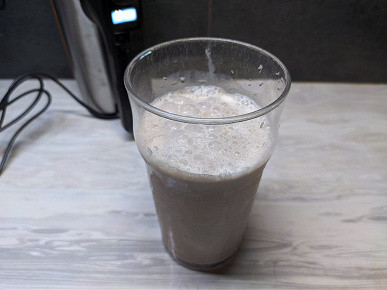A hand mixer is a simple appliance that is used to mix or beat various ingredients. It should have multiple speeds, including turbo mode, to handle different tasks. It is important that when using the mixer, the contents of the dishes do not splash, and the device itself should not be too heavy to ensure comfortable use for a long time.

Today we are testing the Redmond MH2800 hand mixer, which seems to satisfy all these conditions. Let's check it out!
Characteristics
| Manufacturer | Redmond |
|---|---|
| Model | MH2800 |
| Type | hand mixer |
| Country of Origin | China |
| Guarantee | 1 year |
| Nominal/maximum power | 300/400 W |
| Protection against electric shock | class II |
| overheat protection | There is |
| Housing material | stainless steel, plastic |
| Nozzle material | stainless steel |
| Number of speeds | 6 |
| Turbo mode | There is |
| Speed in main mode | 600—1200 rpm ±15% |
| Speed in turbo mode | 1250 rpm ±15% |
| Weight | 1.1 kg |
| Dimensions (W×H×D) | 85×185×147 mm |
| Network cable length | 1.4 m |
Equipment
The box, in the traditional dark gray Redmond style, contains a detailed description of the product. On the wide sides there is a picture of a mixer with whipping attachments turned on, and on the sides there is information about the technical characteristics of the device and a list of its features.

Having opened the box, inside we found:
- mixer
- two sets of nozzles
- instructions
- service book
- promotional materials
At first sight
At first glance, the mixer makes an impression: it certainly does not belong to the premium segment, but the presence of a metal body (although in fact it is a sheet of stainless steel hiding plastic) immediately makes it a representative of the middle class.

Let's take a closer look at all the details. The mixer body has a quadrangular shape with rounded corners and gradually tapers downwards. The stainless steel surface has a matte finish, making it less susceptible to fingerprints. However, the plastic parts can be either matte or glossy.
Designed for a comfortable grip, the handle has a matte finish on the bottom where it contacts your fingers. However, on the other side, where the control panels are located, the surface is made of glossy plastic, which does not seem very logical. After all, it is these parts that will most often be touched by hands, which may not be completely clean during cooking.

The control panel includes four buttons and a backlit black and white LED display. We will look at this panel in more detail in the corresponding section.
From above you can see the ventilation trim, made of glossy (again!) plastic and plastic painted in metallic silver.
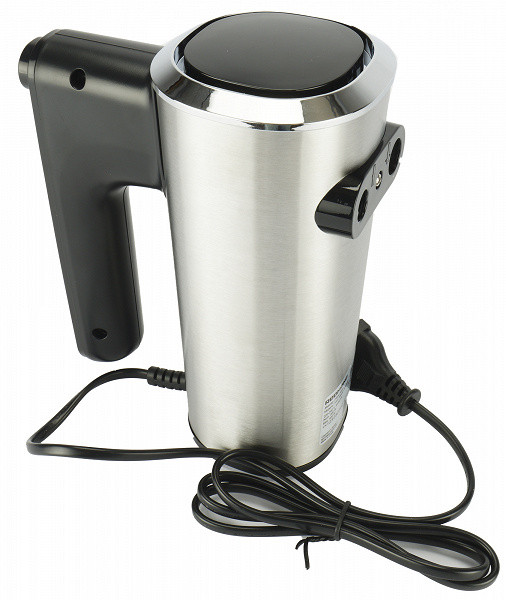
There are ventilation holes on the bottom edge, next to the cord attachment point.

Note that the cord is attached to the mixer body using a swivel mount, which allows it to be tilted almost 90 degrees relative to the body. The cord is 1.2 meters long and can simply be wound around the body of the device for storage, as there are no special fastenings or storage compartments.
The sockets for installing nozzles have a standard design with plastic fasteners equipped with cross-shaped recesses. The attachment snaps into these recesses with light pressure.
To remove the attachments, press the button located on the opposite side of the mixer.

Perhaps little can be said about the nozzles themselves: they are made entirely of stainless steel and their shape is the most ordinary.

They are inserted into the sockets of the nozzles with some resistance, but they are held very securely. The eject button, which releases the attachments, requires pressing with a certain amount of force. We think this is important: the attachments should stay firmly in place and not pop out accidentally. The set includes two sets of attachments: for whipping and for kneading.

The mixer weighs a little — 965 g without attachments, and with them — a whole kilogram. It's certainly not the lightest device and may feel a little heavy for some users, especially when kneading dough or dough for a long time.
Instructions
The brochure has a black cover on high-quality glossy paper, the first page after the table of contents is a diagram of the device without explanation. The explanation of this diagram is located a few pages further, after the safety warnings and technical specifications.

The instructions describe preparatory measures before starting work, methods of beating and mixing, as well as rules for caring for the mixer after completion of work. The information in it is standard, without any special subtleties. However, it is worth noting the mention of an overheating protection system, which can automatically turn off the device if it is used for a long time. If the mixer suddenly stops during operation, you should turn it off, unplug it and let it cool for one and a half hours. The kit also includes a service book.
Control
The mixer is controlled using four buttons, each of which has an intuitive label. The bottom row contains the device's on/off buttons and the «Turbo» button (indicated as «T»). In the top row there are the “+” and “−” buttons, which are responsible for changing the speed. However, their location may seem somewhat unusual: for many users, it is more common to see the speed increase button on the right rather than on the left.

The mixer display shows the selected speed and also starts a timer that shows the operating time from the moment it was turned on. After turning off the mixer, the speed is reset, and the next time you turn it on, work starts from the first speed.
The mixer automatically turns off after 5 minutes of operation.
Exploitation
Before use, we washed the attachments and wiped the body. Having installed the necessary attachments, we turned on the device and started working.
The overall impression of using the mixer is positive: it is easy and simple to operate, all actions are intuitive and do not cause difficulties.
Performance was quite high, especially in the most powerful mode and in turbo mode. However, the noise level also increased significantly. It is important to remember that prolonged operation at maximum speeds is not recommended. The time of continuous operation of the mixer should not exceed 5 minutes, after which it is necessary to take a break for at least 20 minutes.
We were also wary of the digital display. Although the idea is generally good, the quality of the display turned out to be low and, in our opinion, worsens the impression of the device. Additionally, the display does not turn off when idle, which can be annoying if the mixer is left plugged in.
Care
According to the instructions, the mixer attachments can be washed in the dishwasher. When cleaning by hand, use regular dish detergent, avoiding abrasive or harsh chemicals.
The housing should be wiped with a damp cloth and avoid getting water inside the device. It is not recommended to wash the mixer body.
Our measurements
The mixer power varies from 70 to 130 W depending on the selected speed, reaching up to 150 W in turbo mode. During real-life use, we measured an average power of about 140 W at medium speeds.
To assess the noise level, we placed the mixer at a distance of a meter from the sound level meter, pointing the microphone at it, and turned on the device at maximum speed in “Turbo” mode. The measured noise level was up to 77 dBA, which is quite high for a manual kitchen device.
Practice tests
The mixer can knead batter and beat. This is exactly what we will check.
Milkshake
We started with the simplest thing — we tried to make a cocktail from milk and ice cream.

We mastered working with the device and evaluated various speed modes. We noticed that at the highest speeds the milk begins to splash, so it is preferable to use dishes with higher walls.
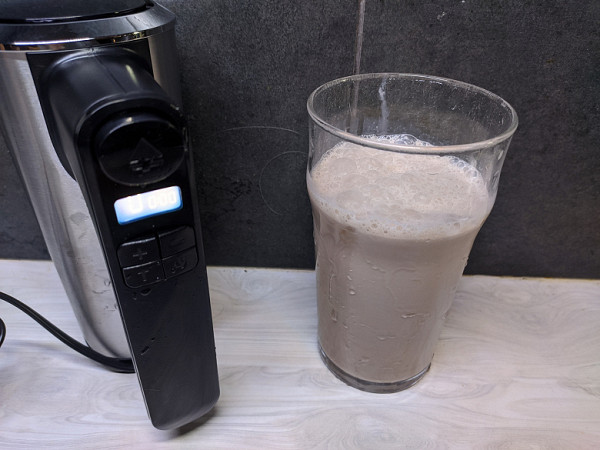
Regarding the quality of the cocktail itself: it came out at an average level. We were not able to obtain stable and fluffy milk foam, but we did not set such a goal. At the same time, all the ingredients were mixed quickly and easily.
Result: average/good
Pancake batter
Our second experiment is pancake batter. I needed eggs, flour and milk.

The dough was kneaded gradually, successively increasing the speed to the most comfortable (3-4).

Once mixing was complete, check for any lumps of flour. None were found, so we started baking.
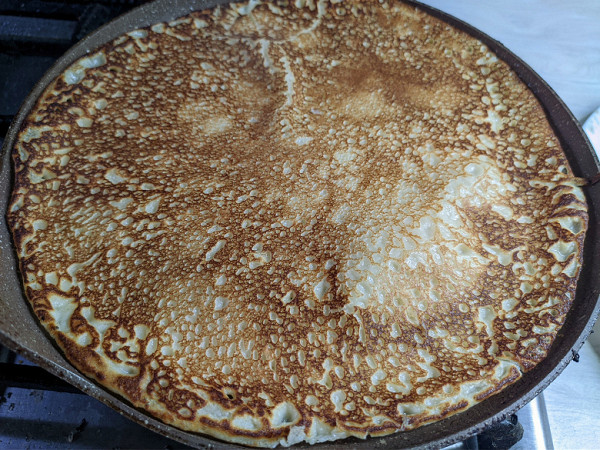
The final result pleasantly surprised us. The pancakes turned out to be tender, but at the same time quite dense. They did not fall apart during frying and were easy to wrap with various fillings.
Result: excellent
Cream
Making a sundae (as well as any dairy ice cream) usually requires constant whisking and stirring. Let's make this process easier by using a mixer.
We took four egg yolks and beat them with 150 grams of sugar. While beating, the mixture gradually turned white and doubled in volume, and the sugar completely dissolved.

It took us about three and a half minutes at almost maximum speed (number five).
Then they began to add milk to this mixture, without stopping whisking.

An almost homogeneous mixture was obtained.
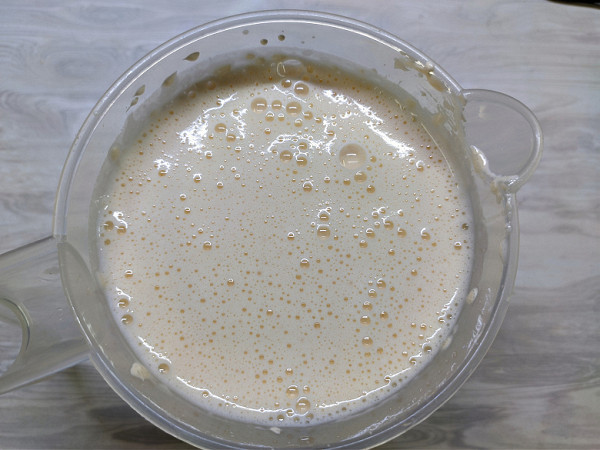
It took a little more time to dissolve the remaining grains of sugar.
After that, we poured the mixture into a saucepan and began to heat it until thickened, stirring constantly. Here, unfortunately, the mixer was not useful to us: the process is quite lengthy and requires frequent stirring, so we had to make do with a regular silicone spatula.
But the mixer helped us perfectly with whipping 35% cream.

In just one minute, room temperature cream turned into a thick mass.
In just one minute, room temperature cream turned into a thick mass.

The main thing here is not to go too far: if you over-whip the cream, it may lose its texture.
All that remains is to mix all the ingredients and put it in the freezer. Then you will need to remove and mix the mass every 15-20 minutes. Here you can use a mixer or do it by hand.
Although the process was not very fast, we eventually achieved the desired result.

Result: excellent
Charlotte type cupcake
A simple tea cake, like a charlotte, is easy and quick to prepare. We needed three proteins, about 60 g of flour and a little sugar.

We started by beating the whites, which reached the desired consistency easily and quickly (in 1-1.5 minutes).

Add sugar to the whites and stir until it is completely dissolved. After that, we mixed everything with flour and put it in a baking dish.

Mix everything thoroughly again and put it in the oven, preheated to 180 degrees.

Bake for 30-35 minutes until done.

Removed, allowed to cool, sliced and served.
Result: excellent
conclusions
The Redmond MH2800 mixer left us with an overall positive impression. Despite its weight, which is a whole kilogram, the device was comfortable to use. Any more weight and it would have become overly heavy. The design of the device can be described as ergonomic. It was convenient for us to hold it by the handle, change speeds, and also wash the attachments and wipe the body.

What didn't we like? First of all, there is a high noise level. If you plan to use the mixer frequently and for a long time, this can be a serious drawback. This is especially true if there are children or other people in the house who need silence. We also didn't like the display: it looks pretty cheap and doesn't turn off while the mixer is plugged in. In our opinion, a conventional mechanical speed switch would be a more suitable option.
Pros:
- nice design
- easy installation of attachments
- quickly and efficiently mixes and whips products
Minuses:
- high noise level
- the display looks cheap and does not turn off while the device is plugged in

